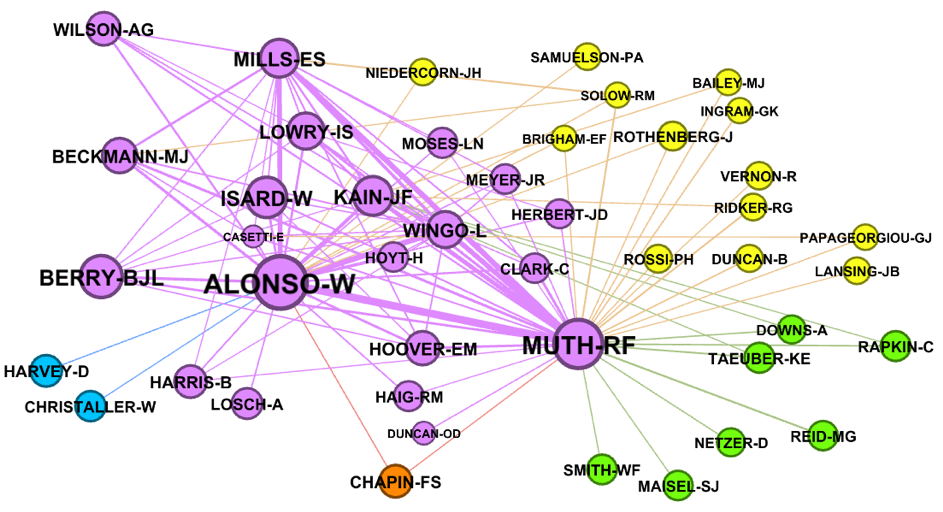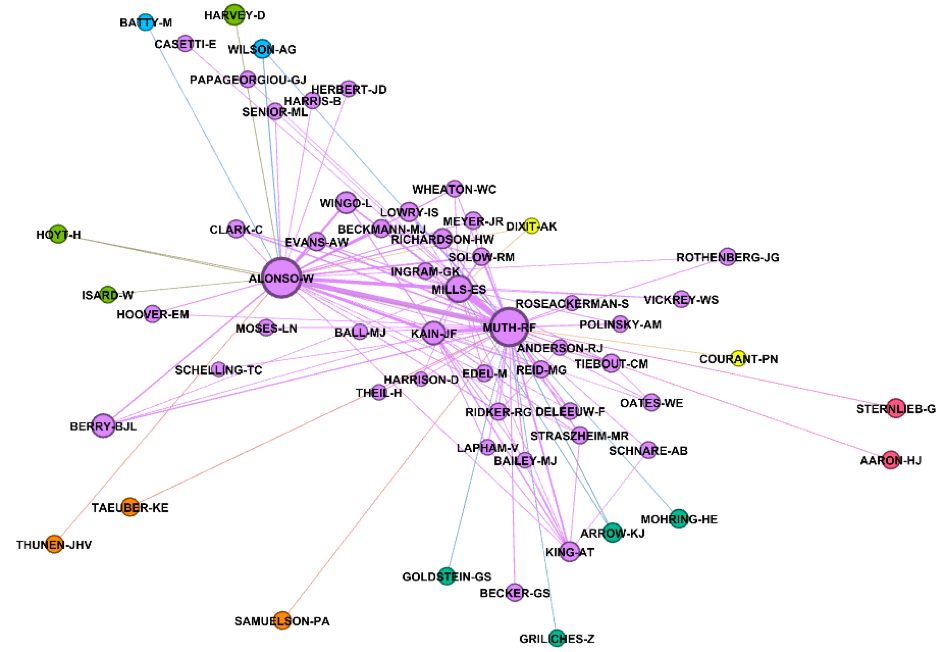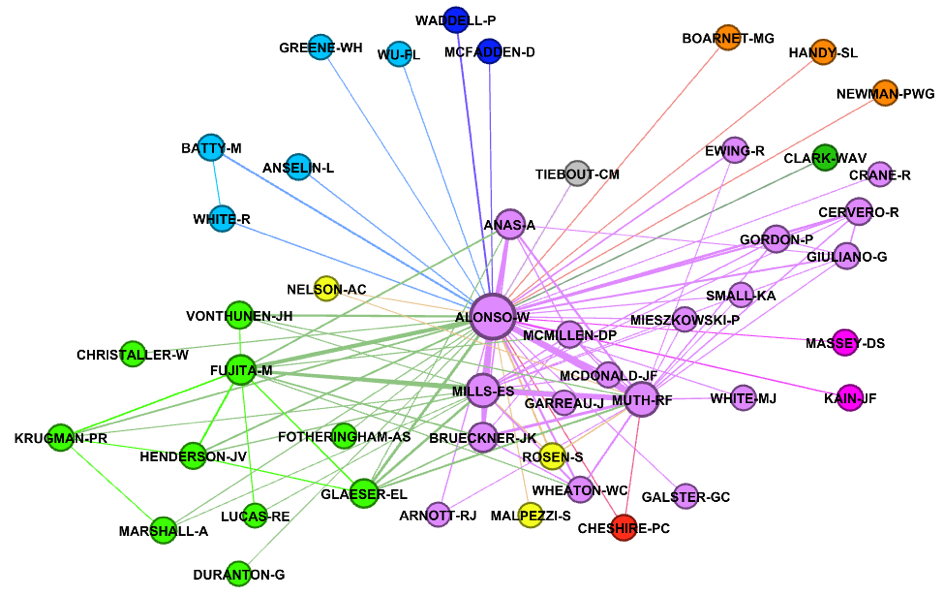Cities and Space: Towards a History of ‘Urban Economics’
by Beatrice Cherrier & Anthony Rebours
A map for a hostile territory?
The field of ‘Urban Economics’ is an elusive object. That economic phenomena related to the city might need a distinctive form of analysis was something economists hardly thought about until the early 1960s. In the United States, it took a few simultaneous scholarly articles, a series of urban riots, and the attention of the largest American philanthropies to make this one of the hottest topics in economics. The hype about it was, however, short-lived enough so that, by the 1980s, urban economics was considered a small, ‘peripheral’ field. It was only through the absorption into a new framework to analyze the location of economic activities – the ‘New Economics Geography’ – in the 1990s that it regained prominence.
Understanding the development of urban economics as a field, or last least the variant which originated in the US and later became international, presents a tricky task. This is because the institutional markers of an academic field are difficult to grasp. A joint society with real estate economists was established in 1964, and a standalone one in 2006; a journal was founded in 1974, with an inaugural editorial which stated that: “Urban economics is a diffuse subject, with more ambiguous boundaries than most specialties. The goal of this Journal is to increase rather than decrease that ambiguity;” a series of handbooks was shared with the neighboring field of regional economics; textbooks and courses about urban and geographical, urban and spatial, or urban and real estate economics were published; and programs that mixed urban economics with neighboring disciplines such as urban geography and urban planning emerged. Situated within a master-discipline (economics) that is often described as exhibiting an articulated identity, clear boundaries with other sciences and strict hierarchies, urban economics is an outlier.
There is, however, one stable and distinctive object that has been associated with the term ‘urban economics’ throughout the 1970s, the 1980s, the 2000s and the 2010s: the Alonso-Muth-Mills model (AMM). It represents a monocentric city where households make trade-offs between land, goods and services, and the commuting costs needed to access the workplace. The price of land decreases with distance from the city center. The model was articulated almost simultaneously in William Alonso’s dissertation, published in 1964, a 1967 article by Edwin B. Mills, and a book by John Muth published in 1969. This trilogy is often considered as a “founding act” of urban economics.
Alonso (1964) and Muth (1969) are the most cited of all the articles published in the Journal of Urban Economics, with Mills (1967) being ranked at 9. If there is a coherent field of ‘urban economics’ to be studied, it makes sense to focus on these three publications in particular. To do so, we collected citations to each of these ‘AMM’ texts in all the journals indexed in the Web of Science database between 1965 and 2009. We then reconstruct a partial map of the field through representing, across 5 year periods, the network of scholars who authored texts co-cited with either one or several of these three ‘foundational’ texts. We thus interpret a citation to one of these three contributions as signaling a specific interest in the kinds of work being done in the field of urban economics. By mapping the authors most co-cited alongside Alonso, Muth or Mills in successive time windows, we aim to reconstruct some sort of core urban economics community (without making claims about the entire scope or outer boundaries of the field). We have supplemented this rough map of the changing fate of AMM with individual and institutional archives, so as to delineate and flesh out the territory populated by urban economists. Below is a summary of the main trends that we identify.
Agglomeration
In 1956, William Alonso moved from Harvard, where he had completed architecture and urban planning degrees at the University of Pennsylvania. He became Walter Isard’s first graduate student in the newly founded department of “regional science.” He applied a model of agricultural land use developed 150 years earlier by the German economist Johann Von Thünen to a city where all employment is located in a Central Business District. His goal was to understand how the residential land market worked and could be improved. His resulting PhD, Location and Land Use, was completed in 1960. Around that time, young Chicago housing economist Richard Muth spent a snowstorm lockdown thinking about how markets determine land values. The resulting model he developed was expanded to study population density. And a book based on it was published a decade later: Cities and Housing. Drafts of Alonso and Muth’s work reached inventory specialist Edwin Mills in 1966, while he was working at the RAND corporation, and trying to turn models describing growth paths over time into a model explaining distance from an urban center. His “Aggregative Model of Resource Allocation in a Metropolitan Area” was published the next year.
As is clear from the network map below, this new set of models immediately drew attention from a wide array of transportation economists, engineers and geographers concerned with explaining the size and transformation of cities, why citizens chose to live in centers or suburbs, and how to develop an efficient transportation system. The economists included Raymond Vernon and Edgar Hoover, whose study of New York became the Anatomy of the Metropolis; RAND analyst Ira Lowry, who developed a famous spatial interaction model; spatial and transportation econometrician Martin Beckman, based at Brown; and Harvard’s John Kain, who was then working on his spatial mismatch hypothesis and a simulation approach to model polycentric workplaces. Through the early works of Brian Berry and David Harvey, quantitative urban geographers also engaged with these new urban land use models.

But the development of a new generation of models relying on optimization behavior to explain urban location was by no mean sufficient to engender a separate field of economics. Neither Alonso, who saw himself as contributing to an interdisciplinary regional science, nor Muth, involved in Chicago housing policy debates, cared much about its institutionalization. But both were influenced and funded by men who did. Muth acknowledged the influence of Lowdon Wingo, who had authored a land use model. Together with Harvey Perloff, a professor of social sciences at the University of Chicago, they convinced the Washington-based think-thank Resource for the Future to establish a “Committee for Urban Economics” with the help of a grant by the Ford Foundation. The decision was fueled by urbanization and dissatisfaction with the urban renewal programs implemented in the 1950s. Their goal was to “develop a common analytical framework” through the establishment of graduate programs in urban economics, and supporting dissertations, and coordinating the organization of workshops and the development of urban economics textbooks.
Their agenda was soon boosted by the publication of Jane Jacobs’ The Death and Life of Great American Cities, and by growing policy interest in the problems of congestion, pollution, housing segregation and ghettoization, labor discrimination, slums, crime and local government bankruptcy, and by the stream of housing and transportation acts which were passed in response to these. The Watts riots, followed by the McCone and Kerner commissions, acted as an important catalyst. The Ford Foundation poured more than $ 20 millions into urban chairs, programs and institutes through urban grants awarded to Columbia, Chicago, Harvard and MIT in 1967 and 1970. The first round of funds emphasized “the development of an analytical framework”, and the second sought “a direction for effective action.”
As a consequence of this massive investment, virtually every well-known US economist turned to urban topics, as shown by the several names of theorists and public or labor economists expanding the 1975-79 network below. At MIT, for instance, Ford’s money was used to set up a two-year “urban policy seminar,” which was attended by more than half of the department.The organizer was welfare theorist Jerome Rothenberg, who had just published a book on the evaluation of urban renewal policies. He was developing a large-scale econometric model of the Boston area with Robert Engle and John Harris, and putting together a reader with his radical colleague Matt Edel. Department chair Carry Brown and Peter Diamond were working on municipal finance. Robert Hall was studying public assistance while Paul Joskow examined urban fire and property insurance. Robert Solow developed a theoretical model of urban congestion, published in a 1972 special issue of the Swedish Journal of Economics, alongside a model by taxation theorist Jim Mirrlees investigating the effect of commuter and housing state tax on land use. Solow’s former student Avinash Dixit published an article modeling a tradeoff between city center economies of scale and commuting congestion costs in another special issue on urban economics in the Bell Journal the next year. A survey of the field was also published in the Journal of Economic Literature, just before the foundation of the Journal of Urban Economics in 1974.

Authors co-citation network 1975-1979 (11 or more links), the size of the nodes and links being proportional to the total number of co-citations.
Segregation
But the publication of a dedicated journal, and growing awareness of the “New Urban Economics” was not the beginning of a breakthrough. It turned out to be the peak of this wave. On the demand side, the growing policy interest and financial support that had fueled this new body of work receded after the election of Richard Nixon and the reorientation of federal policies. On the supply side, the mix of questions, methods and conversations with neighboring scholars that had hitherto characterized urban economics was becoming an impediment. More generally, the 1970s was a period of consolidation for the economics profession. To be considered as bona fide parts of the discipline, applied fields needed to reshape themselves around a theoretical core, usually a few general equilibrium micro-founded workhorse models. Some old fields (macro and public economy for instance) as well as newer ones (health, education, household) developed such theoretical models. Others resisted, but could rely on separate funding streams and policy networks (development and agricultural). Urban economics was stuck.
Policy and business interest was directed toward topics like housing, public choice and transportation. And, combined with the growing availability of new microdata, micro-econometrics advances, and the subsequent spread of the personal computer, this resulted in an outpouring of applied research. Computable transportation models and real estate forecasting models were especially fashionable.
On the other hand, a theoretical unification was not in sight. Workhorse models of the price of amenities, the demand for housing, or suburban transportation, were proposed by Sherwin Rosen, William Wheaton and Michelle White, among others. But explanations of the size, number, structure and growth of cities were now becoming contested. J. Vernon Henderson developed a general equilibrium theory of urban systems based on the trade-off between external economies and diseconomies of city size, but in these agglomeration effects did not rely on individual behavior. Isard’s former student Masahita Fujita proposed a unified theory of urban land use and city size that combined externalities and the monopolistic competition framework pioneered by Dixit and Joseph Stiglitz, but without making his framework dynamic or relaxing the monocentric hypothesis. At a point when there was growing interest in the phenomenon of business districts – or Edge cities as journalist Joël Garreau called them, this was considered a shortcoming by many economists. General equilibrium modelling was rejected by other contributors, including by figures like Harry Richardson, and a set of radical economists moving closer to urban geographers (such as David Harvey, Doreen Massey and Allen Scott) working with neo-Marxist ideas.
Renewal
In the 1990s, various trends aimed at explaining the number, size, evolution of cities matured and were confronted to one another. In work which he framed as contributing to the new field of “economic geography,” Krugman aimed to employ his core-periphery model to sustain a unified explanation for the agglomeration of economic activity in space. At Chicago, those economists who had spent most of the 1980s modeling how different types of externalities and increasing returns could help explain growth – among them Robert Lucas, José Scheikman and his student Ed Glaeser – increasingly reflected on Jane Jacob’s claim that cities exist because of the spillover of ideas across industries which they facilitate. Some of them found empirical support for her claim than for the kind within-industry knowledge spillovers Henderson was advocating.
Krugman soon worked with Fujita to build a model with labour mobility, trade-offs between economies of scale at the plant level and transportation costs to cities. Their new framework he was adamant to compare to Henderson’s general equilibrium model of systems of cities. He claimed that their framework enabled the derivation of agglomeration from individual behavior and could explain not only city size and structure, but also location. In his review of Krugman and Fujita’s 1999 book with Venables, Glaeser praised the unification of urban, regional and international economics around the microfoundations of agglomeration theory. He also contrasted Krugman’s emphasis upon transportation costs – which were then declining – with other frameworks focusing on people’s own movement, and began to sketch out the research program focused on idea exchanges that he would develop in the next decades. He also insisted on the importance of working out empirically testable hypotheses.
The “New Economic Geography” was carried by a newly-minted John Bates Clark medalist who had, from the outset, promised to lift regional, spatial and urban economics from their “peripheral” status through parsimonious, micro-founded, tractable and flexible models. It attracted a new generation of international scholars, for some of whom working on cities was a special case of contributing to spatial economics. In the process, however, olders ties with geographers were severed, and questions that were closely associated with changing cities, like the emergence of the digital age, congestion, inequalities in housing, segregation, the rise of crime and urban riots, became less central to the identity of this field. The field lost some sort of autonomy. Within our own maps, this can be seen from the contrast between the many disparate links which leading urban economists had to Alonso-Muth-Mills, and the discrete, interconnected (green) network in which figures like Fujita, Krugman, Henderson, Lucas, and Glaeser are embedded.

Most recently, Glaeser’s insistence that urban models need to be judged by their empirical fit may be again transforming the identity of urban economics. The shift is already visible in the latest volume of the series of Handbooks in Urban and Regional Science. Its editors (Gilles Duranton, Henderson and William Strange) explain that, while its previous volume (2004) was heavily focused on agglomeration theory, this one is “a return to more traditional urban topics.” And the field is now characterised not in terms of a unified, theorical framework, but with reference to a shared empirical epistemology about how to develop causal inferences from spatial data. There is also growing evidence that students going on the US economics job market increasingly add “spatial economics” and/or “urban economics” to their field list.
Overall, the successive shifts in urban economists’ identity and autonomy which we describe here, were sometimes prompted by external pressures (urban crises and policy responses) and sometimes from internal epistemological shifts about what counts as “good economic science.” A key development in the 1970s was the unification around general equilibrium, micro-founded models. It is widely held that the profession is currently experiencing an “applied turn” or a “credibility revolution”, centered on the establishment of causal inference (gold) standards. How this will affect urban economics remains unclear.
Beatrice Cherrier is an associate professor at the Centre National de la Recherche Scientifique (CNRS). She documents the “applied turn” in the history of recent economics through chasing institutional artifacts like the JEL codes, researching the history of selected applied field (urban, public, macro) and unpacking its gendered aspects.
Anthony Rebours is currently a graduate student at University Paris 8 and a young fellow of the Center for the History of Political Economy (CHOPE) at Duke University. His interests are about the recent history of economics and its relations with geography, and the use of sociological methods for quantitative history.
Other posts from the blogged conference:
Economists in the City: Reconsidering the History of Urban Policy Expertise: An Introduction, by Mike Kenny & Cléo Chassonnery-Zaïgouche
